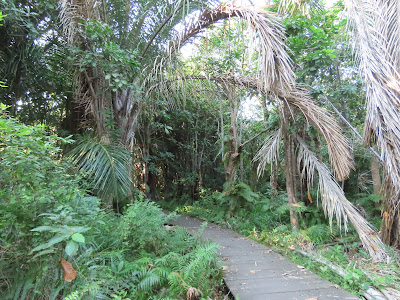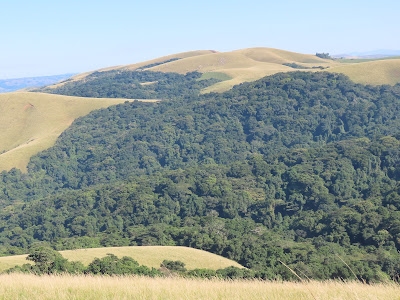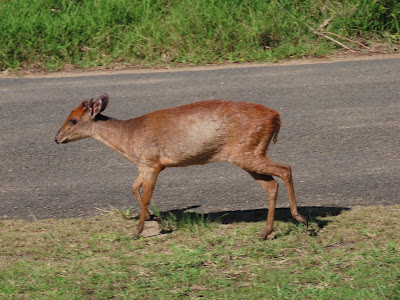The board walk through the raffia palms Raphia australis always reminds me of Jurassic Park - the expectation of being chomped by T-rex is ever present. The leaves of the palm feature in The Guiness Book of World Records as the largest in the floral kingdom and the fruit is the primary food source for palmnut vultures, none of whom were present on this day.
Returned from a walk one morning to find visitors that had made themselves at home, a rather windy bunch it must be said!
A visit to the finfoot channel proved fruitless.....................
......................but this black-bellied starling sitting in the sun was some compensation..........
..........while a three-banded plover appeared to be admiring it's reflection.
The full extent of the lagoon only becomes apparent when Titus the drone is utilized.........
.........and the reeds in the vlei positively glow in the late afternoon light.
I was headed off to Ongoye forest one morning and happened to notice this African crake snoozing in the early rays...................
.............but a short while later breakfast was served and it started pottering around on the roadside. What a fine specimen and the only time I've seen one previously was in 2001.
Ongoye was fairly unproductive from a photographic point of view, though I spent a considerable amount of time trying to get a pair of yellow-streaked greenbuls to sit still. It is a very impressive expanse of forest and is one of only two places in the world where green barbets can be found, but they were only heard in the distance.
However on my return to camp I found a lone palmnut vulture perched atop a raffia right at the gate. Previously know as a vulturine fish eagle, the birds may be seen on the beach feeding on dead fish, but they supplement that diet with the thin layer of protein rich flesh that lies between the husk and the nut of the palms. As the palms have become more popular in coastal areas they have increased their range southwards from Kosi Bay and are now being seen on the Wildcoast.
Such a magnificent bird deserves more than one picture.
Had to go down to the lagoon for a celebratory sundowner.
On an early stroll through the forest I noticed this bark spider crouched in the middle of her exquisite web.....
......and a noisy trumpeter hornbill showing off his majestic casque, the extra length being the only difference between males and females
A bird party in a patch of acacia provided great views of a dark-backed weaver belting out it's musical song,........
.......a family of tawny-flanked prinia, only easily identified by the continuous cocking of a long tail,......
.........and a real treat in the shape of a brown-backed honeybird, a rarely seen brood parasite that cons the previous species into raising it's chicks.
Nearby tidal pools were the temporary feeding grounds of a pair of red-billed teal.
I'd been told of an area where black coucal had been seen so went to check it out but everything was so muddy that I took a stroll along the river and witnessed the rare occurrence of an ore train heading north.
Trying to find a shorter way to the Siyayi lagoon, the trail took me past this enormous swamp fig Ficus trichopoda whose adventitious root system makes it appear multi-stemmed.
A hollow in the crook of a nearby tree contained these pretty mushrooms whose name has eluded me.
Several visits to the mangroves provided only one brief glimpse of the mangrove kingfisher which only visits during winter, but there were numerous little egrets foraging on the shoreline. Though not visible here, the dainty yellow slippers are definitive.
Next stop was an old favourite - Bonamanzi. Was surprised to see impala with lambs so late in the year but have since noticed even smaller ones that could only be a few days old. Perhaps they work on a different schedule to those in Kruger.
This place is bird heaven, so get ready for a deluge. Undoubtedly the most consistently noisy are the yellow-bellied greenbuls whose peh-peh-peh calls soon start sounding like a nagging wife - apologies ladies.
The African green pigeons love sunbathing in the early mornings and may often be seen on the tops of trees, very pretty but unfortunately not showing it's eye-catching yellow socks.
A special in this area is Rudd's apalis that makes a lot of noise for such a small bird, the narrow necklace makes this a female.
When I was here a couple of years ago I stumbled on a tree that was new to me and when I keyed it out using Richard Boon's excellent book, I found that it was also new to science. Originally discovered by the aforesaid Richard, it has yet to be officially named and currently goes by Berchemia sp. nov. Richard, who now lives in Melbourne, asked if I could look for more specimens while I was here to add to the total of 35 he knew of and supply any other relevant information. He is currently writing up what will become the official description of the species with assistance of Braam van Wyk - a legend in the botanical world. I have so far increased the total by 9 and will hopefully add to that while here.
One of the beauties of Bonamanzi is that you may walk on any of the many trails and though I have seen evidence of the 25 odd elephant, I hadn't yet met one. I was rather relieved that I was in the bakkie when I encountered old Baba, who, at 54, has recently been ousted from the herd by his son. I'm assured that as long as you maintain a respectful distance they are unlikely to stomp on you!































